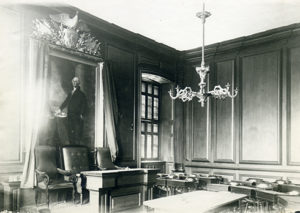
The Governor’s Chamber at the Colony House, with Gilbert Stuart’s portrait of President George Washington on display, P9400, NHS Collection.
Why have one of something when you can have five? This thought, encouraged by the very individual-based idea of democracy among the men who shaped Rhode Island’s colonial government, had them decide that sessions of the General Assembly would rotate among the county capitols, in effect distributing the seat of power. Seats of government were constructed in five counties – Newport, Providence, Kingston, East Greenwich, and Bristol. Legislators held sessions in each building at different times of the year, but the legislative session always began in Newport in May. The buildings also served the counties locally as courthouses, among other things. The rotation of the General Assembly between the five county seats ended in 1854 by Article of amendment III to the state constitution. Sessions were then only held in Newport and Providence. The rotation ended altogether in 1901 when the government of Rhode Island consolidated in the current State House in the capital city of Providence.
The Newport Colony House (1739) replaced a smaller 1690 building on the same site.
Old State House, Providence (1762) modeled after the Newport Colony House, replaced an earlier 1730 courthouse.
King’s County Courthouse, in what is now Kingston, Washington County (1776) replaced an earlier 1729 courthouse.
Kent County Courthouse, East Greenwich (1805) replaced a 1750 courthouse.
Bristol Courthouse (1817) replaced a 1766 courthouse.
All five of these buildings are still standing.
Banner: Undated print depicting Washington Square and the Colony House, P9363, NHS Collection.